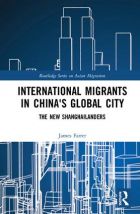International Migrants in China’s Global City: The New Shanghailanders

Overall, China has very few international migrants, who make up less than .1 per cent of the country’s population. A quarter of these are in Shanghai, and the urban master plan aims to increase their numbers several times over by 2035.
Shanghai is thus something of an outlier in China, partly reflected in its history as a British treaty port until 1943. International Migrants in China’s Global City focuses on relatively affluent and skilled Western migrants to Shanghai, a city they often perceive as very distinct from the rest of China. Farrer describes Shanghai as “a city which both seems designed for such elite Westerners and can seem unfriendly to any permanent migrants…a global city in which permanent inward migration is difficult and legal permanent residency for foreigners is still quite uncommon” (page 22).
The book draws on more than 400 interviews collected over almost two decades. It explores varied fields in which skilled migrants are socialized into and reproduce Shanghai’s expatriate community, including economic, social, sexual and educational domains. This is enlivened by personal anecdotes about the author’s experiences of belonging and not belonging to this community. The structure of the book even follows his general phases of life and time periods in Shanghai, from entrepreneurial singledom to navigating sexual and geographical mobility to learning expat educational strategies for children.
Interestingly, Farrer argues that traditional forms of privilege, including whiteness, have less currency than before. High-end spaces for socializing are no longer dominated by Westerners, as Chinese nationals become increasingly prosperous, as China-based international firms increasingly opt to employ ethnic Chinese migrants, and as the Chinese government issues scarce residency permits primarily to overseas Chinese in an increasingly strict visa regime. Social capital has transformed as well:
“their community resources seemed relatively impoverished in the increasingly wealthy city of Shanghai. The altered political environment is the decisive factor. For one, there are no longer any explicitly political organizations. Moreover, most organizations cannot be registered with the city government, and thus cannot own property. Overall, the image is one of a decline of community social capital compared to the Shanghailanders of the colonial period.” (page 84)
Even if individual white Western Shanghailanders might bemoan the (slight) reduction of their privilege, the book tries to avoid this almost neocolonial nostalgia. For one thing, it depicts how the ethnic capital of whiteness remains useful for instance in academia, to attract students who want an “international” experience.
This ethnic capital also translates into sexual capital, for middle-aged straight and gay white men who find themselves more popular in Shanghai than they would have been elsewhere. Mobility is key to this sexual capital, influencing for instance the perceived desirability of Chinese-American men over Chinese nationals. But this has also declined amidst the increasing affluence of Chinese nationals. Cultural and political norms have played a role as well (page 144): “After the housing reforms of the 1990s, Chinese men were increasingly expected to own a home – or property – to be eligible to marry. The fact that foreigners very rarely owned homes in Shanghai made them less attractive as partners in this mainstream – and increasingly patriarchal – Chinese marriage market.”
One takeaway from all these fields is that Shanghai has been changing rapidly over the last several decades, and this is likely to continue. Today’s sexual, educational, social and economic spheres for foreign migrants will be reshaped along with Chinese global power.
Further reading:
Huang, Tsung-yi Michelle (2006), “The cosmopolitan imaginary and flexible identities of global city‐regions: articulating new cultural identities in Taipei and Shanghai”, Inter-Asia Cultural Studies Vol 7, No 3, pages 472–491, available at https://www.tandfonline.com/doi/abs/10.1080/14649370600849330?scroll=top....
Iossifova, Deljana (2015), “Everyday practices of sanitation under uneven urban development in contemporary Shanghai”, Environment and Urbanization Vol 27, No 2, pages 541–554, available at https://journals.sagepub.com/doi/full/10.1177/0956247815581748.
Tacoli, Cecilia (2010), “Editorial: Governance, migration and local development”, Environment and Urbanization Vol 22, No 1, pages 5–11, available at https://journals.sagepub.com/doi/pdf/10.1177/0956247810364111.
Book note prepared by Christine Ro
Search the Book notes database
Our Book notes database contains details and summaries of all the publications included in Book notes since 1993 - with details on how to obtain/download.
Use the search form above, or visit the Book notes landing page for more options and latest content.
For a searchable database for papers in Environment and Urbanization, go to http://eau.sagepub.com/

